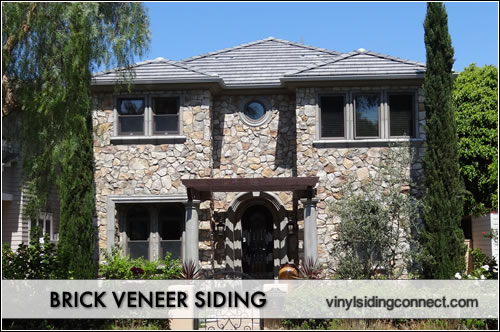Brick veneer siding is a great option for those interested in a distinctive look for their home. Although brick veneer siding is more expensive than other types such as aluminum or vinyl siding, it is a less expensive choice compared to solid brick or stone while offering the same looks and much of the same benefits.



Basics Of Brick Veneer Siding
Brick veneer siding provides the good looks of real brick without the hefty price tag, difficult installation or heavy weight that comes along with installing solid bricks. Brick veneer has an external face that resembles real brick, usually about 1″ thick (but it can range from ½” – 4″ thick) that can be made from molded clay mixed with rock or cement, from salvaged and reclaimed bricks, or from polyurethane. No matter what the material used to create the brick veneer, it is molded and properly colored if necessary (iron oxide is used to make the brick red if the veneer is made from clay) to mimic the look of solid brick. The difference is that unlike solid brick, brick veneer siding is much thinner and is therefore lighter, less expensive and easier to install.

Brick Veneer Cost
Price Range: $12.00 – $17.00 psf installed
Brick veneer costs less than solid brick, but it is generally more expensive than many other types of exterior siding. Homeowners can expect brick veneer siding to cost b/n $12 – $17 per sq. ft. This assumes that additional structural work will not be needed in order to support the weight of the veneer. Learn more on brick veneer cost.

Advantages Of Brick Veneer Siding

Distinctive Look
The most obvious benefit of brick veneer is the look. There are few siding options that compare in aesthetic impact to a brick home and brick veneer can provide that look at a lower price tag than using solid brick.

Fireproof And Durable
Other benefits to this type of siding include excellent thermal and sound insulation, fireproof qualities, strength and durability (it will not rot, splinter, warp or fade), and easy maintenance requirements.

Lasts Quite A Long Time
With proper maintenance, this cladding should last 100 years or more and will require minimal maintenance over the life of the veneer. In contrast, most vinyl siding is made to last 20 – 40 years.

Disadvantages

Construction Requirements
Walls made from solid brick may be as much as 8″ – 12″ thick and can support the load of any wall or roof that bears down on it. Brick veneer siding, on the other hand, is installed to offer the good looks of brick, but cannot be used as a way to support the walls. For this reason, the walls must first be constructed to bear the proper load and then the brick veneer can be applied to the exterior face of the wall to make it look like the walls were constructed of solid brick.

Installation Requirements
Thin brick veneer can be mounted onto plywood and then installed on a wall in one piece, or each piece can be individually mounted. Prior to installation of the veneer, a vapor barrier should be installed because brick veneer is permeable to water. This will help to prevent any moisture penetration. One major drawback to using brick veneer is its ability to allow moisture to penetrate. Because it is permeable, moisture penetration can result in rot and the build-up of mold behind the veneer, so proper installation is imperative to ensure that moisture cannot penetrate through to the wood beneath. This type of install is generally easier than installing solid bricks, but it is still best to have a professional handle the installation for the reasons mentioned above.
Related Topics
Board And Batten
Fiber Cement Options
Stucco & Cement
Wood & Lap Options




